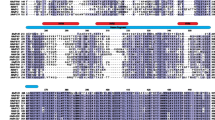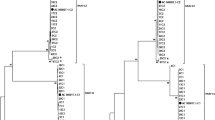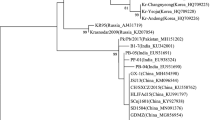Abstract
To date, human adenoviruses are classified into 53 types (types 1–51 and types 53 and 54), which have been grouped into six species named A through F, and the recently identified type 52 has been proposed as member of a new species, G. Type classification is based on type-specific epitopes within loop 1 (L1) and loop 2 (L2) of the hexon protein, which contain seven hypervariable regions that are responsible for type specificity. In this paper, we present the characterization of an adenovirus strain isolated from a male AIDS patient in Cordoba, Argentina. This strain was found to be a member of species D by genomic Sma I restriction analysis. Sequencing of the L1 and L2 regions of the hexon gene and immunological characterization by virus neutralization revealed this hexon to be unique and distinct from the previously identified hexons of types within species D. A seroepidemiologic study in the human population of Cordoba showed that this strain was not endemic in the local human population.



Similar content being viewed by others
References
Ariga T, Shimada Y, Shiratori K, Ohgami K, Yamazaki S, Tagawa Y, Kikuchi M, Miyakita Y, Fujita K, Ishiko H, Aoki K, Ohno S (2005) Five new genome types of adenovirus type 37 caused epidemic keratoconjunctivitis in Sapporo, Japan, for more than 10 years. J Clin Microbiol 43:726–732
Benko M, Harrach B, Both GW, Russell WC, Adair BM, A′dam E, de Jong JC, Hess M, Johnson M, Kajon A, Kidd AH, Lehmkuhl HD, Li Q, Mautner V, Pring-Akerblom P, Wadell G (2005) Family Adenoviridae. In: Fauquet CM, Mayo MA, Maniloff J, Desselberger U, Ball LA (eds) Virus taxonomy. Eighth report of the international committee on the taxonomy of viruses. Elsevier Academic Press, San Diego, pp 213–228
Carrigan DR (1997) Adenovirus infections in immunocompromised patients. Am J Med 102:71–74
Crawford-Miksza L, Schnurr D (1996) Adenovirus serotype evolution is driven by illegitimate recombination in the hypervariable regions of the hexon protein. Virology 224:357–367
Crawford-Miksza L, Schnurr D (1996) Analysis of 15 adenovirus hexon proteins reveals the location and structure of seven hypervariable regions containing serotype-specific residues. J Virol 70:1836–1844
De Jong JC, Wermenbol A, Verweij-Uijterwaal M, Slaterus K, Wertheim-Van Dillen P, Van Doornum G, Khoo S, Hierholzer J (1999) Adenoviruses from human immunodeficiency virus-infected individuals, including two strains that represent new candidate serotypes Ad50 and Ad51 of species B1 and D, respectively. J Clin Microbiol 37:3940–3945
Ebner K, Pinsker W, Lion T (2005) Comparative sequence analysis of the hexon gene in the entire spectrum of human adenovirus serotypes: phylogenetic, taxonomic, and clinical implications. J Virol 79:12635–12642
Echavarría M (2008) Adenoviruses in immunocompromised hosts. Clin Microbiol Rev 21:704–715
Eiz B, Pring-Akerblom P (1997) Molecular characterization of the type-specific gamma-determinant located on the adenovirus fiber. J Virol 71:6576–6581
Engelmann I, Madisch I, Pommer H, Heim A (2006) An outbreak of epidemic keratoconjunctivitis caused by a new intermediate adenovirus 22/H8 identified by molecular typing. Clin Infect Dis 43:64–66
Fox J, Hall C (1980) Adenoviruses. In: Viruses in families. PSG publishing, Littleton, pp 294–334
Gall J, Crystal RG, Falck-Pedersen E (1998) Construction and characterization of hexon-chimeric adenoviruses: specification of adenovirus serotype. J Virol 72:10260–10264
Gall J, Kass-Eisler A, Leinwand L, Falck-Pedersen E (1996) Adenovirus type 5 and 7 capsid chimera: fiber replacement alters receptor tropism without affecting primary immune neutralization epitopes. J Virol 70:2116–2123
Giordano MO, Martinez LC, Rinaldi D, Espul C, Martinez N, Isa MB, Depetris AR, Medeot SI, Nates SV (1999) Diarrea and enteric emerging virases in HIV-infected patients. AIDS Res Hum Retroviruses 16:1427–1432
Grandien M, Pettersson CA, Svensson L, Uhnoo I (1987) Latex agglutination test for adenovirus diagnosis in diarrheal disease. J Med Virol 23:311–316
Hierholzer J (1992) Adenoviruses in the immunocompromised host. Clin Microbiol Rev 5:262–274
Hierholzer J, Adrian T, Anderson L, Wigand R, Gold J (1988) Analysis of antigenically intermediate strains of subgenus B and D adenoviruses from AIDS patients. Arch Virol 103:99–115
Hierholzer J, Stone Y, Broderson J (1991) Antigenic relationships among the 47 human adenoviruses determined in reference horse antisera. Arch Virol 121:179–197
Hierholzer J, Wigand R, Anderson L, Adrian T, Gold J (1988) Adenoviruses from patients with AIDS: a plethora of serotypes and a description of five new serotypes. J Infect Dis 158:804–813
Ishiko H, Aoki K (2009) Spread of epidemic keratoconjunctivitis due to a novel serotype of human adenovirus in Japan. J Clin Microbiol 47:2678–2679
Ishiko H, Shimada Y, Konno T, Hayashi A, Ohguchi T, Tagawa Y, Aoki K, Ohno S, Yamazaki S (2008) Novel human adenovirus causing nosocomial epidemic keratoconjunctivitis. J Clin Microbiol 46:2002–2008
Jones II M, Harrach B, Ganac R, Gozum M, dela Cruz W, Riedel B, Pan C, Delwart EL, Schnurr D (2007) New adenovirus species found in a patient presenting with gastroenteritis. J Virol 11:5978–5984
Madisch I, Harste G, Pommer H, Heim A (2005) Phylogenetic analysis of the main neutralization and hemagglutination determinants of all human adenovirus prototypes as a basis for molecular classification and taxonomy. J Virol 79:15265–15276
Madisch I, Wölfel R, Harste G, Pommer H, Heim A (2006) Molecular identification of adenovirus sequences: a rapid scheme for early typing of human adenoviruses in diagnostic samples of immunocompetent and immunodeficient patients. J Med Virol 78:1210–1217
Matsui K, Shimizu H, Yoshida A, Nagaoka E, Nishio O, Okuda K (2008) Monitoring of adenovirus from conjunctival scrapings in Japan during 2005–2006. J Med Virol 80:997–1003
Rezig D, Bahri O, Ben Ayed N, Ben Yahia A, Sadraoui A, Ayed S, Triki H (2006) Identification of adenoviruses serotypes implicated in haemorrhagic conjunctivitis in Tunisia. Pathol Biol (Paris) 54:561–565
San Martin C, Burnett RM (2003) Structural studies on adenoviruses. Curr Top Microbiol Immunol 272:57–94
Sarantis H, Johnson G, Brown M, Petric M, Tellier R (2004) Comprehensive detection and serotyping of human adenoviruses by PCR and sequencing. J Clin Microbiol 42:3963–3969
Schnurr D, Dondero M (1993) Two new candidate adenovirus serotypes. Intervirology 36:79–83
Shinagawa M, Matsuda A, Ishiyama T, Goto H, Sato G (1983) A rapid and simple method for preparation of adenovirus DNA from infected cells. Microbiol Immunol 27:817–822
Takeuchi S, Itoh N, Uchio E, Aoki K, Ohno S (1999) Serotyping of adenoviruses on conjunctival scrapings by PCR and sequence analysis. J Clin Microbiol 37:1839–1845
Van Oostrum J, Smith PR, Mohraz M, Buenett RM (1987) The structure of adenovirus capsid III. Hexon packing determined from electron micrographs of capsid fragments. J Mol Biol 198:73–89
Verma H, Chitambar SD, Varanasi G (2009) Identification and characterization of enteric adenoviruses in infants and children hospitalized for acute gastroenteritis. J Med Virol 81:60–64
Wadell G (1984) Molecular epidemiology of human adenoviruses. Curr Top Microbiol Immunol 110:191–220
Walsh MP, Chintakuntlawar A, Robinson CM, Madisch I, Harrach B, Hudson NR, Schnurr D, Heim A, Chodosh J, Seto D, Jones MS (2009) Evidence of molecular evolution driven by recombination events influencing tropism in a novel human adenovirus that causes epidemic keratoconjunctivitis. PLoS One 4(6):e5635
Wigand R, Keller D, Werling I (1982) Immunological relationship among human adenoviruses of subgenus D. Arch Virol 72:199–209
Yeung R, Eshaghi A, Lombos E, Blair J, Mazzulli T, Burton L, Drews SJ (2009) Characterization of culture-positive adenovirus serotypes from respiratory specimens in Toronto, ON, Canada, September 2007–June 2008. J Virol 26:11
Acknowledgments
This study was supported by grant from the Secretaria de Ciencia y Tecnica from Universidad Nacional de Cordoba, Argentina. We thank Dr. Teryl Frey for language assistance and Dr. Dean Erdman for providing the prototype Adenovirus strains (type 33) and antisera (types 29, 33, 43-47) from CDC (Atlanta, EE UU).
Author information
Authors and Affiliations
Corresponding author
Rights and permissions
About this article
Cite this article
Ferreyra, L., Giordano, M., Martinez, L. et al. A novel human adenovirus hexon protein of species D found in an AIDS patient. Arch Virol 155, 27–35 (2010). https://doi.org/10.1007/s00705-009-0539-x
Received:
Accepted:
Published:
Issue Date:
DOI: https://doi.org/10.1007/s00705-009-0539-x




